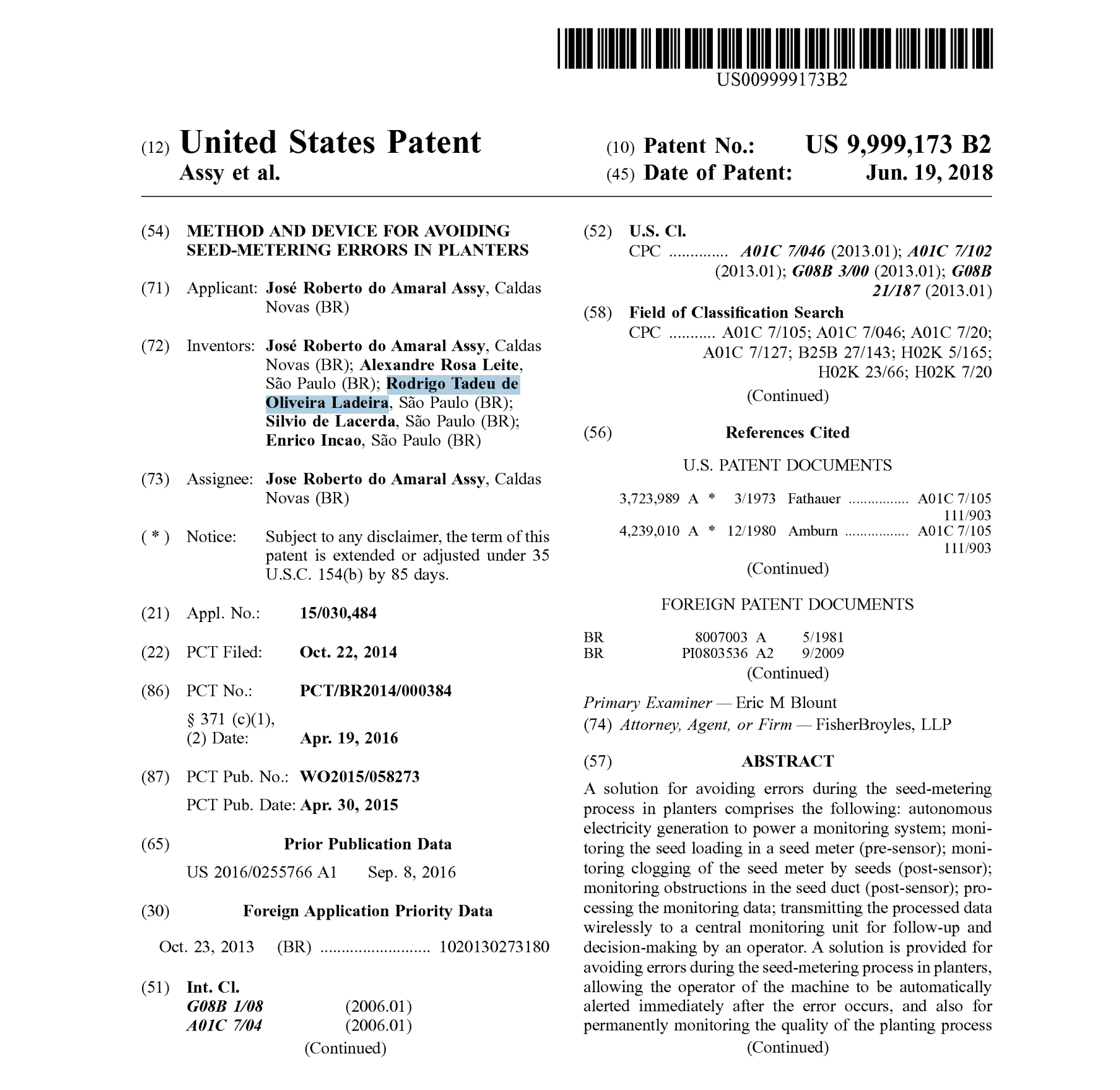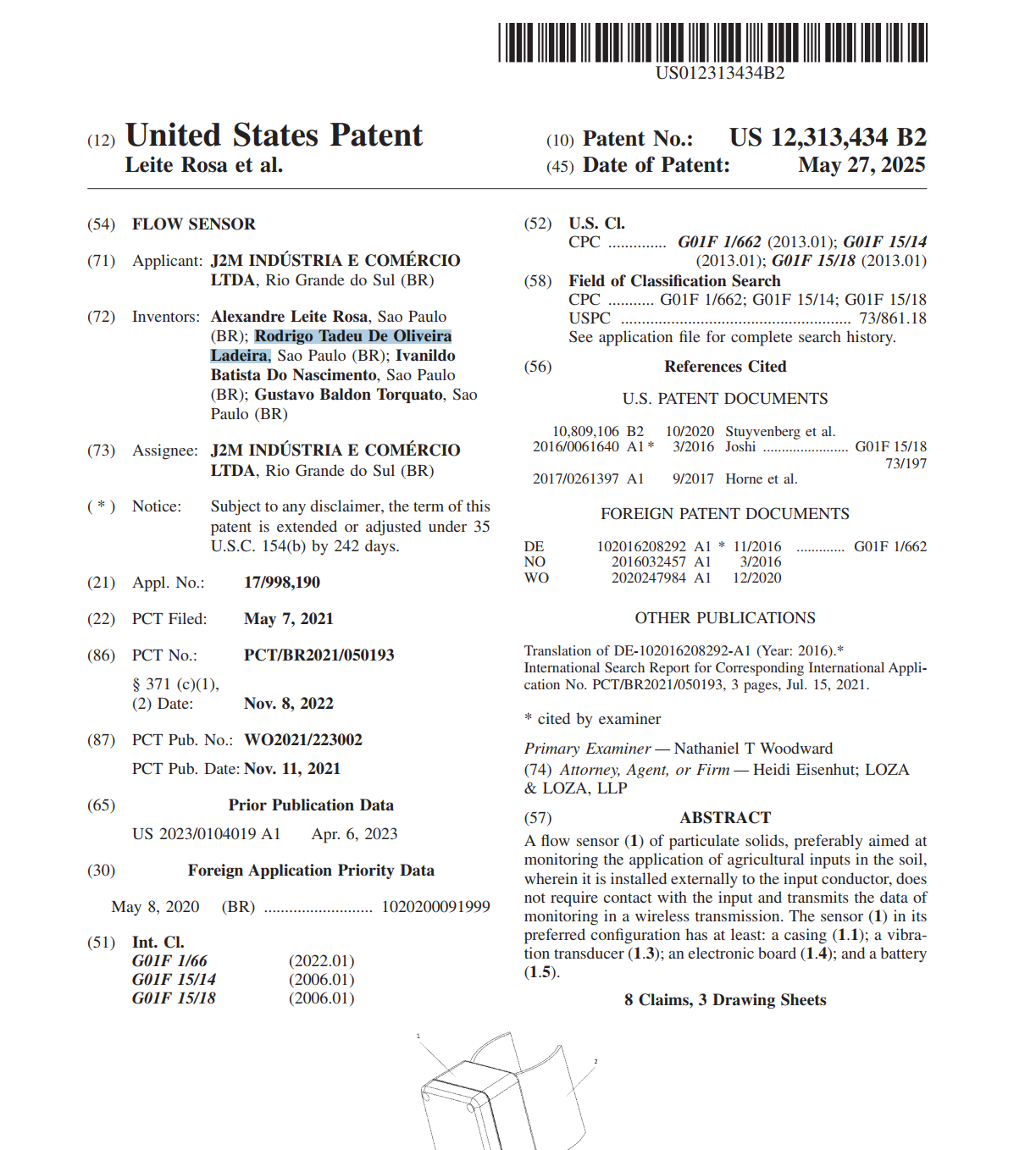Method and Device for Avoiding Seed-Metering Errors in Planters
Intellectual Property and Patents
Co-Inventor – US Patent 9,999,173 B2
Co-Inventor – US Patent 10,405,484 B2
This patent describes an intelligent monitoring system for agricultural planters, aimed at detecting and preventing seed-metering errors during sowing operations. The invention combines pre- and post-sensors to monitor seed flow, identify blockages, and detect disk malfunctions in real time. It integrates autonomous energy harvesting via a dynamo and solar panel, embedded processing with custom firmware, and wireless data transmission to a central unit. The solution improves planting accuracy, reduces waste, and enables timely intervention by alerting the operator when errors occur.
System, Apparatus and Method for Foot-Operated Effects
Co-Inventor – US Patent Application US20140090546A1
This invention describes a programmable foot-operated pedal for audio effects, designed to combine the portability and robustness of traditional stage pedals with the flexibility of digital software-based systems. It includes a Human-Machine Interface (HMI), a processing unit (CPU), an audio interface for signal conditioning, and a PC interface for configuration and updates. Users can create and customise their own effects using open standards and freely available programming environments, eliminating the dependency on proprietary software. The system enables real-time audio manipulation through a compact, stage-ready device, aimed at musicians and sound designers seeking creative control.
Wireless Particulate Solid Material Flow Sensor with Internal Battery
Co-Inventor – US Patent 10,502,606 B2
This patent presents a low-power, wireless sensor designed to monitor the flow of particulate materials such as seeds, fertilizers, or granulated products in agricultural machinery. The system features a rigid resonant conductor coupled to passive piezoelectric transducers that detect mechanical vibrations caused by particle flow. It includes an internal battery, microprocessor, and RF transceiver, enabling autonomous operation without external power or wiring.
The device operates in ultra-low power modes and communicates wirelessly with a central unit, which alerts operators in real time to flow interruptions or anomalies.
Flow Sensor for Particulate Solids with Wireless Trans. and Non-Contact Sensing
Co-Inventor – US Patent 12,313,434 B2
This invention describes a wireless, non-invasive flow sensor for monitoring the application of particulate agricultural inputs—such as seeds or fertilisers—without altering existing machinery or contacting the material directly. Unlike conventional systems, this sensor is installed externally to the input conductor and uses a vibration transducer (preferably piezoelectric) to detect the mechanical impacts of particles flowing inside the tube.
Its design ensures robust, low-maintenance operation in harsh agricultural environments.
This sensor offers fast installation, preservation of implement integrity, low power consumption, and avoidance of flow obstruction or seed damage—solving key limitations of existing market solutions.
Academic Publications
Computational Tool: Daily Load Curve Forecasting Based on Temperature Prediction
link
This paper presents the development of a computational tool designed to forecast daily electrical load curves based on temperature predictions. The methodology relies on a statistical analysis of historical data and applies a linear regression model to correlate ambient temperature with electricity demand. The system was implemented within the SISGEN platform, an energy management system developed by the University of São Paulo (USP), and was tested on USP facilities.
By using historical temperature and load data from just ten previous days, the tool can predict the load curve for a target date using forecasted average temperature as input. The results show that for weekdays, the tool achieved an average forecasting error of approximately 4%, demonstrating its effectiveness for short-term planning and energy consumption management. The tool supports energy managers in reducing costs and improving operational planning by anticipating daily peak demands.




